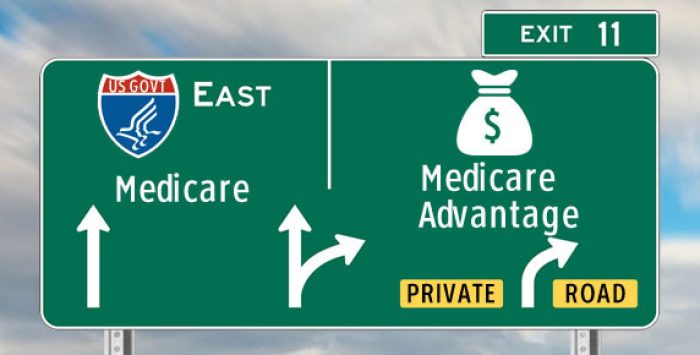Does income affect Medicare premiums?
Yes, your income can affect your premiums for Medicare Part B and Medicare Part D. People with high incomes pay higher premiums for both of these parts of Medicare. The income threshold for premium surcharges is indexed for inflation each year. In 2024, the threshold is $103,000 for a single individual. For 2025, the threshold will increase to $106,000 for a single individual.
Most people do not pay any premium for Medicare Part A, but even for those who do, there is no income-related surcharge, so Part A premiums are not affected by income.
What is IRMAA?
Medicare beneficiaries who earn over $106,000 a year and who are enrolled in Medicare Part B and/or Medicare Part D – pay the income-related monthly adjusted amount (IRMAA), which is a surcharge added to the Part B and Part D premiums.
Since 2007, high-income Medicare enrollees have been required to pay the IRMAA surcharge for Medicare Part B coverage. An IRMAA surcharge for Medicare Part D premiums took effect in 2011.
For Medicare beneficiaries who receive Social Security retirement benefits, the premium for Part B is deducted from their Social Security check. This is true regardless of whether the person is subject to the IRMAA surcharge. But the “hold harmless” provision that prevents Social Security checks from decreasing from one year to the next does not apply to people who pay the IRMAA surcharge.
(The “hold harmless” provision has not been widely applicable in recent years, due to fairly large cost-of-living adjustments (COLA) for Social Security benefits. The 2023 COLA was historically large, and Part B premiums declined for 2023, including the Part B premiums that are paid by people subject to the IRMAA surcharge. For 2024, the average Social Security retiree benefit increased by $59/month, and standard Part B premiums increased by just under $10/month. For 2025, the average Social Security retirement benefit is increasing by about $50/month, and the Part B premium is increasing by a little more than $10/month. So the hold harmless provision continues to be non-applicable in nearly all cases.)
How many people pay Medicare's high-income surcharges?
Most Medicare beneficiaries do not pay IRMAA surcharges. According to the Medicare Trustees Report, about 4.9 million Medicare beneficiaries paid Part B IRMAA surcharges in 2024, amounting to about 7% of the 67 million total enrollees. And about 4.2 million beneficiaries paid IRMAA surcharges for their Part D prescription drug coverage. (The IRMAA income thresholds are the same for both Part B and Part D, but more beneficiaries have Part B than have Part D.)
Does 'Medicare income limits' mean the same thing as IRMAA?
When people talk about “income limits” with regard to Medicare, they could be referring to the threshold where IRMAA surcharges start to apply for those on the higher end of the income spectrum. (Above a certain income limit, you’ll be subject to IRMAA, but below it, you won’t.)
But they could also be referring to the income thresholds that apply to Medicare Savings Programs and dual eligibility for Medicare and full Medicaid, for those on the lower end of the income spectrum. (Note that on the lower end, eligibility rules also include asset limits, in addition to income limits.)
So you’d need to know the context to determine which program is being discussed: Is it an upper income limit, below which a person has access to certain financial assistance with their coverage? Or are they referring to the highest income a person can have and not be subject to paying additional premiums for their Medicare coverage?
How is my income used in my IRMAA determination?
IRMAA is determined by income from your income tax returns two years prior. This means that for your 2024 Medicare premiums, your 2022 income tax return was used. And for your 2025 premiums, your 2023 tax return will be used.
IRMAA applicability and amounts are recalculated annually. The IRMAA surcharge will be added to your 2025 premiums if your 2023 income was over $106,000 (or $212,000 if you’re married). You will receive notice from the Social Security Administration to inform you if you are being assessed IRMAA. But as discussed below, there’s an appeals process if your financial situation has changed.
For those who are curious about how the inflation indexing works in terms of determining what income level counts as “high” each year, Harry Sit, of The Finance Buff, explains how it works. The indexing is based on the percentage by which the average of the Consumer Price Index for Urban Consumers (CPI-U) for the 12-month period ending in the most recent August exceeds the average of the 12-month period that preceded that. You can replicate the calculations using CPI-U data from this page (select the first box under “Price Indexes”).
How is income calculated for Medicare's IRMAA determinations?
The income used to determine IRMAA is a form of Modified Adjusted Gross Income (MAGI), but it’s specific to Medicare. The Modified Adjusted Gross Income may differ from your Adjusted Gross Income, because some people have additional income sources that must be added to their AGI to determine their IRMAA-specific MAGI.
It’s important to understand that MAGI for calculating IRMAA isn’t the same as the MAGI that you might be accustomed to for non-healthcare purposes, nor is it exactly the same as MAGI for calculating premium tax credits and Medicaid/CHIP eligibility under the Affordable Care Act. Table 1 in this Congressional Research Service brief is useful in seeing how MAGI is determined for IRMAA calculations.
How have Medicare's income-related surcharges changed over time?
There have been a few recent changes that affect high-income Medicare beneficiaries:
- In 2019, a new income bracket was added at the high end of the scale, for people earning $500,000 or more ($750,000 for a married couple). Prior to 2019, the highest income bracket was $160,000+ ($320,000+ for a married couple). But in 2019, the new income bracket meant that a beneficiary earning $500,000+ would be paying a larger premium than someone earning $160,000.
- 2020 was the first year that the income thresholds for IRMAA surcharges were adjusted for inflation. Prior to that, it started at $85,000 and that number had been unchanged since the program began. But starting in 2020, the thresholds were adjusted for inflation, with the low-end threshold increasing to $87,000 for a single person.
- For 2021, the IRMAA thresholds were indexed again, with the low-end threshold increasing to $88,000 for a single person.
- For 2022, the IRMAA thresholds started at $91,000 for a single person and $182,000 for a married couple.
- For 2023, the IRMAA thresholds increased significantly, to $97,000 for a single person and $194,000 for a married couple.
- For 2024, the IRMAA thresholds again increased significantly, to $103,000 for a single person and $206,000 for a married couple.
- For 2025, the IRMAA thresholds are increasing modestly, to $106,000 for a single person and $212,000 for a married couple
- Going forward, the Modified Adjusted Income requirements will continue to be adjusted by inflation (CPI).
How much are Medicare Part B IRMAA premiums in 2025?
Here are the Part B IRMAA premiums for 2025 (based on 2023 income tax returns; the applicable premium is shown on the right. For incomes that are subject to IRMAA, the premium shown includes the IRMAA surcharge).
| Part B IRMAA premiums (2025) |
| Individual |
Joint |
Monthly Premium |
| $106,000 or less |
$212,000 or less |
$185 (no IRMAA) |
| > $106,000 – $133,000 |
> $212,000 – $266,000 |
$259 |
| > $133,000 – $167,000 |
> $266,000 -$334,000 |
$370 |
| > $167,000 – $200,000 |
> $334,000 – $400,000 |
$480.90 |
| > $200,000 – $500,000 |
> $400,000 – $750,000 |
$591.90 |
| Greater than $500,000 |
Greater than $750,000 |
$628.90 |
Source: Centers for Medicare & Medicaid Services
(Note that as of 2023, people who have had kidney transplants have lifetime access to Medicare Part B coverage of immunosuppressive drugs; before 2023, this only lasted for three years post-transplant. There’s a separate set of IRMAA premiums for high-income beneficiaries who are enrolled in immunosuppressive drug coverage only; the high-income premiums for these enrollees range from about $184/month to $552/month in 2025.)
How much are Medicare Part D IRMAA surcharges in 2025?
For Medicare Part D, the IRMAA amounts are added to the regular premium for the enrollee’s plan. Part D plans have varying prices, ranging from as little as $0 to more than $100 per month, depending on where you live and the plan you select. So the full amount, after the IRMAA surcharge, will depend on the plan.
Note that if you are a Medicare Advantage policy member and your plan includes prescription drug benefits (most Medicare Advantage plans do have built-in Part D drug benefits), the Medicare Part B and Part D IRMAAs are both added to the plan premium (Medicare Advantage enrollees pay the Medicare Part B premium in addition to any premium charged by their Medicare Advantage plan).
The following income levels (based on 2023 tax returns) trigger the associated IRMAA surcharges for 2025 Part D coverage:
| Part D IRMAA premiums (2025) |
| Individual |
Joint |
Monthly Premium |
| $106,000 or less |
$212,000 or less |
your premium (no IRMAA) |
| > $106,000 – $133,000 |
> $212,000 – $266,000 |
$13.70 + your premium |
| > $133,000 – $167,000 |
> $266,000 -$334,000 |
$35.30 + your premium |
| > $167,000 – $200,000 |
> $334,000 – $400,000 |
$57 + your premium |
| > $200,000 – $500,000 |
> $400,000 – $750,000 |
$78.60 + your premium |
| Greater than $500,000 |
Greater than $750,000 |
$85.80 + your premium |
Source: Centers for Medicare & Medicaid Services
Can I appeal the IRMAA determination?
You can appeal the IRMAA determination – filing for a redetermination – if you believe the calculation was erroneous. In addition, if you have had a life-changing event such as a loss of income or divorce, then you can refile or you can file for a redetermination using Form SSA-44. For example, if you were still working in 2023 but have since retired, your current income might be lower than the income that was reflected on your 2023 tax return. If that’s the case, you can file for a redetermination, instead of waiting for your tax returns to catch up.
If you do not agree with a redetermination, there is a formalized appeal process – the third level of appeal – technically called the Decision by Office of Medicare Hearings and Appeals (OMHA). (Note that this is a different procedure from the appeal or grievance procedure when you receive denials of service from Medicare Parts A, B, or D.)
Why does Medicare have premium surcharges for people with higher incomes?
The higher premiums for Medicare Part B took effect in 2007, under the Medicare Modernization Act. And for Medicare Part D, they took effect in 2011, under the Affordable Care Act. Medicare premiums cover only a small fraction of the cost of providing coverage, and the IRMAA rules were created to ensure that beneficiaries with the means to do so are required to pay a larger share of the cost of their coverage.
Beneficiaries’ premiums only cover about 25% of the cost of Part B, and about 15% of the cost of Part D — and that’s with IRMAA surcharges in effect for beneficiaries with high incomes. Most of the cost of Medicare Part B and Part D is covered by general revenues, and the IRMAA surcharges help to spread that cost to beneficiaries who can afford to pay a larger share of the cost of their coverage.
The SECURE Act, SECURE ACT 2.0, and IRMAA
Further complications were introduced under the SECURE Act (Setting Every Community Up for Retirement Enhancement Act of 2019), enacted in late 2019. The SECURE Act has a number of different features – such as allowing IRA contributions after age 70½ if you’re still earning an income – and it extended the minimum age that one must receive RMDs (Required Minimum Distributions) from 70½ to 72.
The SECURE Act 2.0, enacted in late 2022, further increased the age that one must begin receiving RMDs to 73 starting in 2023. And it will increase to 75 by 2033.
The reason this may be important is that it is possible that delaying receiving RMDs may also reduce IRMAA if your Modified Adjusted Gross Income is close to the limits stated in the tables above.
When people withdraw from qualified funds such as a 401(k), IRA, or 403(b), these funds are taxable once they are transferred to their individual checking, savings, or brokerage account (assuming the retirement account wasn’t a Roth). The amount distributed is added to your taxable income, so exercise caution when you’re receiving distributions from qualified funds. This additional income will increase your Modified Adjusted Gross Income, and may subject you to higher Medicare Part B and Medicare Part D premiums.
Further, non-qualified funds must also be tracked because of the way mutual funds’ capital gains and dividend distributions are made. At the end of every year, many mutual funds distribute capital gains or dividends to those with mutual fund holdings. As a result, people can unknowingly earn more income as a result of investments, and the result can be higher Medicare premiums.
The inverse is also true and now may be more applicable to you: realized capital losses can reduce your MAGI, and could potentially reduce your Medicare Part B and Part D premiums.
We recommend that you speak with a tax planner or financial advisor if you have questions about your specific circumstances, including investment income or your plans to withdraw money from your retirement accounts.
Financial planning and health insurance go hand in hand
If your income exceeded $106,000 in 2023, your 2025 Medicare Part D and Part B premiums depend on your income. As you can see in the tables above, the additional premiums can be substantial.
Understanding how this works – including what counts as income as far as Medicare is concerned – is a key part of your financial planning. And since the government will base your premiums on your income from two years ago, you’ll also want to have a good understanding of how to appeal an IRMAA determination, in case you experience a life change that reduces your income.
Jae W. Oh is a nationally recognized Medicare expert, frequently quoted in the national press, including on USA Today, Dow Jones, CNBC, and Nasdaq.com, as well as on radio talk shows nationwide. His book, Maximize Your Medicare, is available in print and ebook formats. Jae has appeared as a speaker in front of libraries, companies, as part of college-sponsored programs. The Managing Principal of GH2 Benefits, LLC, Jae is a Certified Financial Planner, Chartered Life Underwriter, a Chartered Financial Consultant, and a licensed insurance producer in multiple states.
Footnotes





